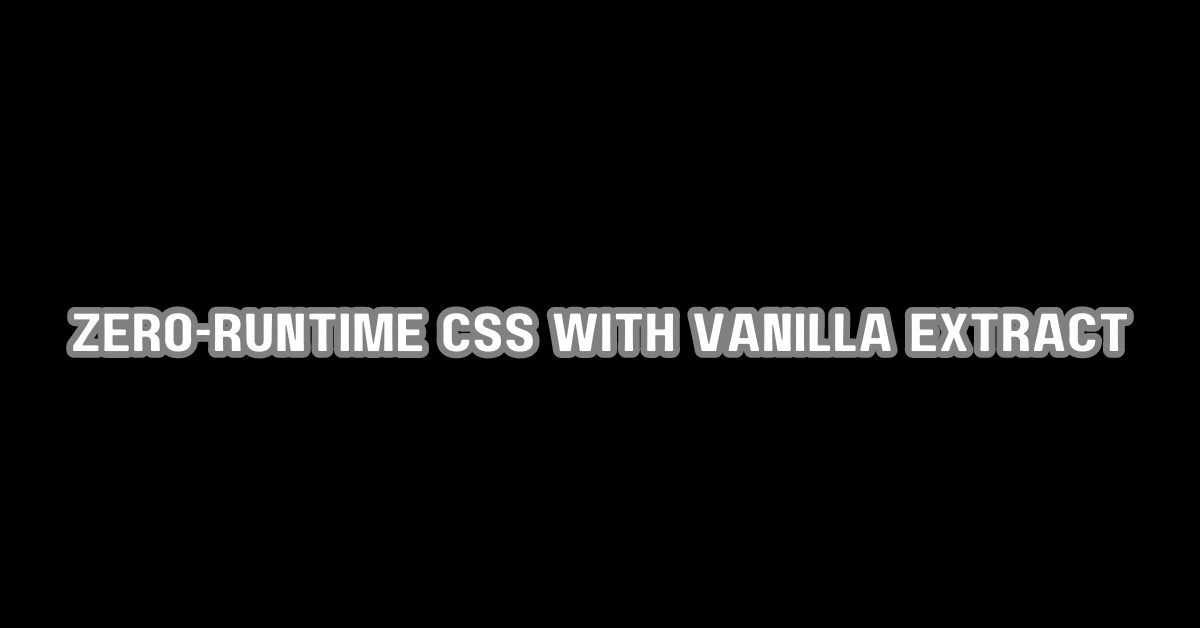Zero-Runtime CSS with Vanilla Extract is a new approach to writing stylesheets that has been gaining popularity in the web development community. This technique allows developers to write CSS in TypeScript, which is then compiled to static CSS stylesheets. The result is a faster and more efficient way of writing styles that avoids the overhead of runtime CSS libraries.

Understanding Zero-Runtime CSS is essential to fully grasp the benefits of Vanilla Extract. Zero-Runtime CSS refers to the idea of writing CSS that is compiled at build time rather than at runtime. This approach eliminates the need for a CSS-in-JS runtime library, which can slow down the performance of web applications. By using Vanilla Extract, developers can write styles that are optimized for performance and maintainability.
Introduction to Vanilla Extract is a crucial step in implementing Zero-Runtime CSS. Vanilla Extract is a library that provides a way to write styles in TypeScript and compile them to static CSS stylesheets. This library also allows developers to use CSS variables, mixins, and other advanced features that are not available in traditional CSS. With Vanilla Extract, developers can write styles that are more expressive and easier to maintain.
Key Takeaways
- Zero-Runtime CSS with Vanilla Extract allows developers to write styles that are optimized for performance and maintainability.
- Understanding Zero-Runtime CSS is essential to fully grasp the benefits of Vanilla Extract.
- Introduction to Vanilla Extract is a crucial step in implementing Zero-Runtime CSS.
Understanding Zero-Runtime CSS

Zero-Runtime CSS is a new concept in web development that is gaining popularity among developers. It is a technique that allows developers to write CSS in JavaScript, which means that CSS is generated dynamically at build time instead of being rendered at runtime. This approach has several benefits, including faster load times, smaller file sizes, and easier maintenance.
Concept of Zero-Runtime CSS
The concept of Zero-Runtime CSS is based on the idea of generating CSS code statically, rather than dynamically. This means that the CSS code is generated during the build process, rather than at runtime. This approach has several benefits, including faster load times, smaller file sizes, and easier maintenance. By generating CSS code statically, developers can eliminate the need for CSS processing at runtime, which can significantly improve website performance.
Zero-Runtime CSS is implemented using a library called Vanilla Extract, which is a CSS-in-JS library that allows developers to write CSS in JavaScript. Vanilla Extract generates CSS code at build time, which means that the CSS code is generated statically, rather than dynamically. This approach has several benefits, including faster load times, smaller file sizes, and easier maintenance.
Benefits of Zero-Runtime CSS
There are several benefits of using Zero-Runtime CSS in web development. One of the main benefits is faster load times. By generating CSS code statically, developers can eliminate the need for CSS processing at runtime, which can significantly improve website performance. This can lead to a better user experience and higher engagement rates.
Another benefit of Zero-Runtime CSS is smaller file sizes. By generating CSS code statically, developers can eliminate the need for CSS processing at runtime, which can significantly reduce the size of CSS files. This can lead to faster load times and better performance on slower internet connections.
Finally, Zero-Runtime CSS makes it easier to maintain CSS code. By writing CSS in JavaScript, developers can use modern programming techniques like variables, functions, and modules. This makes it easier to organize and maintain CSS code, which can lead to faster development times and easier maintenance.
In summary, Zero-Runtime CSS is a new approach to web development that allows developers to write CSS in JavaScript. This approach has several benefits, including faster load times, smaller file sizes, and easier maintenance. By using a library like Vanilla Extract, developers can generate CSS code statically, which can significantly improve website performance.
Introduction to Vanilla Extract

Vanilla Extract is a zero-runtime CSS library that allows developers to write CSS styles in TypeScript or JavaScript. It was created to solve the problems of traditional CSS, which can be hard to maintain, debug, and scale. With Vanilla Extract, developers can write CSS in a type-safe and maintainable way.
What is Vanilla Extract?
Vanilla Extract is a CSS-in-JS library that generates static CSS files at build time. It allows developers to write CSS styles in TypeScript or JavaScript, which are then transformed into CSS files. This means that the CSS is generated at build time, not at runtime, which makes it faster and more efficient.
Key Features of Vanilla Extract
Vanilla Extract has several key features that make it a popular choice for developers:
- Type Safety: Vanilla Extract allows developers to write CSS styles in TypeScript or JavaScript, which provides type safety and eliminates the need for manual testing.
- Zero-Runtime: Vanilla Extract generates static CSS files at build time, which means that there is no runtime overhead or performance penalty.
- Atomic CSS: Vanilla Extract encourages the use of atomic CSS, which is a methodology that involves breaking down CSS styles into small, reusable classes.
- Theme Support: Vanilla Extract has built-in support for theming, which allows developers to create multiple themes for their applications.
- Server-Side Rendering: Vanilla Extract supports server-side rendering, which means that the CSS styles are generated on the server and sent to the client, improving the performance of the application.
Overall, Vanilla Extract is a powerful CSS-in-JS library that provides type safety, performance, and maintainability. It is a great choice for developers who want to write CSS in a modern and efficient way.
Implementing Zero-Runtime CSS with Vanilla Extract

Zero-Runtime CSS with Vanilla Extract is a powerful tool for building web applications with static CSS stylesheets. In this section, we will discuss how to implement Zero-Runtime CSS with Vanilla Extract in your web application.
Setting Up Vanilla Extract
Before we can start using Vanilla Extract, we need to set it up in our project. The first step is to install it using npm. Here’s the command to install Vanilla Extract:
npm install @vanilla-extract/css @vanilla-extract/webpack-plugin
Once installed, we need to configure our webpack configuration to use the Vanilla Extract webpack plugin. Here’s an example webpack configuration:
const { VanillaExtractPlugin } = require('@vanilla-extract/webpack-plugin');
module.exports = {
// ... other webpack configuration
plugins: [
// ... other webpack plugins
new VanillaExtractPlugin(),
],
};
With Vanilla Extract set up, we can start creating our styles.
Creating Styles with Vanilla Extract
To create styles with Vanilla Extract, we use a combination of TypeScript and CSS. We define our styles in TypeScript using CSS-in-JS syntax, and Vanilla Extract compiles them into static CSS stylesheets.
Here’s an example of how to define styles with Vanilla Extract:
import { style } from '@vanilla-extract/css';
export const button = style({
backgroundColor: 'blue',
color: 'white',
padding: '10px 20px',
borderRadius: '5px',
cursor: 'pointer',
});
In this example, we define a style called button with a blue background, white text, padding, border radius, and a pointer cursor. We can use this style in our HTML like this:
<button class="${button}">Click me</button>
When we compile our application with Vanilla Extract, it will generate a static CSS stylesheet with the styles defined in our TypeScript code.
With these simple steps, we can start using Vanilla Extract to create static CSS stylesheets for our web applications. By using static stylesheets, we can improve the performance of our web applications and reduce the amount of CSS code we need to write.
Best Practices and Tips

Efficient Use of Vanilla Extract
When using Vanilla Extract, there are a few best practices to follow to ensure efficient use and optimal performance:
- Minimize the size of your CSS files: Vanilla Extract generates CSS at build time, so the larger your CSS files are, the longer it will take to generate the styles. Consider splitting your CSS files into smaller, more manageable chunks to speed up the build process.
- Use constants for frequently used values: To avoid repetition and make your code more maintainable, use constants for frequently used values such as colors and font sizes. This will also make it easier to make global changes to your styles.
- Avoid using dynamic values: Vanilla Extract generates static CSS, so dynamic values such as
calc()orvar()are not supported. Instead, use static values wherever possible to ensure optimal performance.
Troubleshooting Common Issues
While Vanilla Extract is designed to be easy to use, there are a few common issues that you may encounter:
- CSS not being generated: If you’re not seeing any CSS being generated, make sure that your styles are being imported correctly and that you’re using the correct file extensions (
*.css.tsor*.css.tsx). - Styles not being applied: If your styles are not being applied, make sure that you’re importing them correctly and that you’re using the correct class names.
- Errors during build: If you’re encountering errors during the build process, make sure that you’re using the correct syntax and that your code is valid. Check the error messages for more information on what went wrong.
By following these best practices and troubleshooting tips, you can ensure that your Vanilla Extract code is efficient, performant, and error-free.
Frequently Asked Questions

What is Zero-Runtime CSS-in-JS?
Zero-Runtime CSS-in-JS is a CSS-in-JS solution that generates CSS at build-time instead of runtime. This means that the CSS is extracted and optimized during the build process, resulting in faster page loads and better performance.
What are the benefits of using Vanilla Extract for CSS?
Vanilla Extract is a CSS-in-JS solution that offers several benefits, including:
- Zero-runtime CSS-in-JS
- Type-safety
- Easy integration with existing build tools
- Automatic vendor prefixing
- Ability to use CSS variables, mixins, and functions
How does Vanilla Extract compare to other CSS-in-JS solutions?
Vanilla Extract has several advantages over other CSS-in-JS solutions, including:
- Zero-runtime CSS-in-JS
- Better performance
- Type-safety
- Simpler API
- Automatic vendor prefixing
What is the @vanilla-extract/next-plugin and how does it work?
The @vanilla-extract/next-plugin is a plugin for Next.js that integrates Vanilla Extract into your Next.js project. It automatically generates CSS during the build process and extracts the CSS into a separate file, resulting in faster page loads and better performance.
What are some common use cases for Vanilla Extract?
Vanilla Extract is a versatile CSS-in-JS solution that can be used for a variety of projects, including:
- Web applications
- Static websites
- Component libraries
- Design systems
How do CSS selectors work in Vanilla Extract?
In Vanilla Extract, CSS selectors are defined using the style function. This function takes a CSS object as an argument and returns a className that can be used to apply the styles to an element. For example:
import { style } from '@vanilla-extract/css';
export const buttonStyle = style({
backgroundColor: 'blue',
color: 'white',
padding: '10px',
borderRadius: '5px',
});
// Usage:
<button className={buttonStyle}>Click me</button>
This will generate a className with the styles defined in the buttonStyle object, which can be applied to the button element.
Understanding Javascript Scope: A Comprehensive Guide
Arsalan Malik is a passionate Software Engineer and the Founder of Makemychance.com. A proud CDAC-qualified developer, Arsalan specializes in full-stack web development, with expertise in technologies like Node.js, PHP, WordPress, React, and modern CSS frameworks.
He actively shares his knowledge and insights with the developer community on platforms like Dev.to and engages with professionals worldwide through LinkedIn.
Arsalan believes in building real-world projects that not only solve problems but also educate and empower users. His mission is to make technology simple, accessible, and impactful for everyone.



